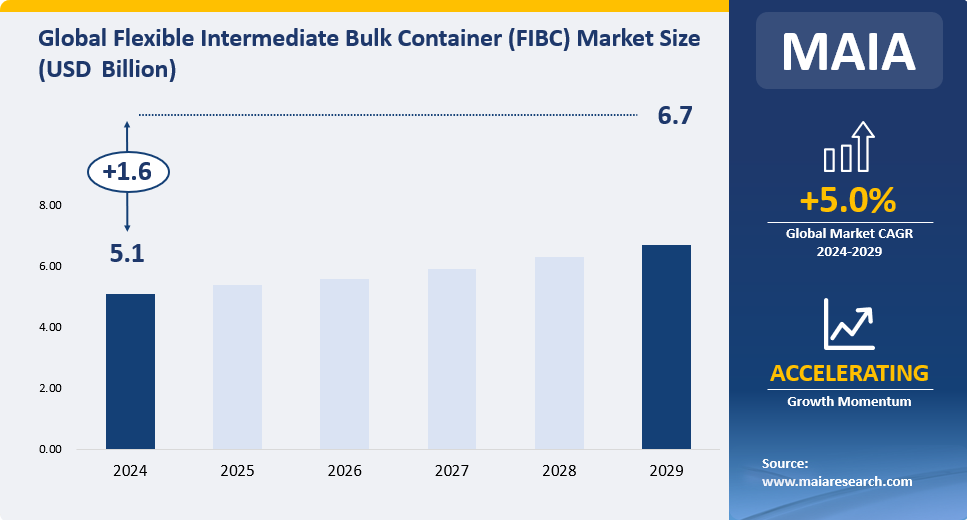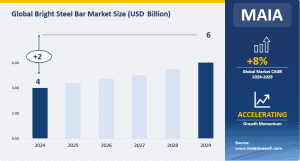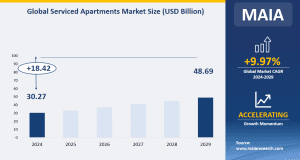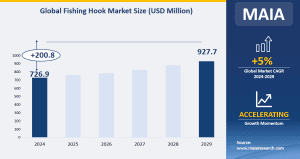The U.S. market accounted for the largest sales share of 25.34% in 2023. In 2023, sales of flexible intermediate bulk containers (FIBCs) in the United States amounted to approximately 117362 K units.

Definition
A flexible intermediate bulk container (FIBC) is a large, flexible bag designed to transport and store bulk quantities of dry or granular materials. These materials can range from powders, granules, and flakes to minerals, chemicals, and food products.
Key players in the flexible intermediate bulk container (FIBC) market include Greif, Inc., LC Packaging International BV, FlexiTuff International Limited, Plastene India Limited, FBIC Vietnam, Shankar Packagings Limited, Rishi FIBC Solutions Private Limited, Jianyuanchun, SafeFlex International Limited, Quick Way FIBC, Kanpur Plastipack Limited, Wellknit, Pera Plastic Group, Emmbi Industries Limited, FIPCO, Virgo Polymer India Limited, Sinobangla Industries Limited, Jai Corp Limited, Jumbo Bag Limited, etc. In 2023, Greif, Inc. held the largest revenue share of the market at around 6.46%. Greif’s FIBC range of aggregates provides safe packaging solutions for the transport of bulk aggregates such as sand, stone and gravel.
Import, Export, Production, Consumption in the US market
In 2023, the US market production was 76648 K units and consumption was 117362 K units. The US market accounted for 14.5% of global production and 25.36% of consumption. The U.S. market imported more than it exported, with 42612 K units imported and 1898 K units exported.
United States Regional Economic Analysis
‘Inflationary factors in the market’
Growth is projected to slow to 0.5% in 2023 with inflation and tight financial conditions weighing on spending. Inflationary pressures – driven by strong demand, supply constraints, and rising commodity prices following Russia’s war of aggression against Ukraine – have broadened, with services inflation now accelerating. Inflationary pressures may prove persistent, prompting additional monetary tightening.
‘Easing the financial pressure on middle-class families should be a major priority’
Middle-class households, which are key drivers of economic growth and social stability, had already been feeling the effects of rising housing, education, healthcare and childcare costs for some years. These rising costs, coupled with weak growth of incomes, have resulted in higher levels of household indebtedness. To ease some of these pressures, the Survey recommends raising public funding for childcare, widening the income eligibility for public programs, fixing minimum federal childcare standards and establishing a consistent quality rating system across states.
Market by Type
Based on type, the flexible intermediate bulk container (FIBC) market can be divided into type A bulk bags, type B bulk bags, type C bulk bags, and type D bulk bags.
Type A bulk bags are made from non-conductive fabric and do not provide any static protection. They are suitable for non-flammable materials that do not pose a risk of electrostatic discharge.
Type B FIBCs are made from antistatic fabric designed to prevent the buildup of electrostatic charges. However, they do not provide full protection against sparks and incendiary discharges.
Type C bulk bags are made from electrically conductive fabric. They are equipped with grounding mechanisms to safely dissipate static charges, making them suitable for flammable materials.
Type D FIBCs use static dissipative fabric to prevent the occurrence of incendiary sparks. They do not require grounding and offer protection against hazardous charges for both flammable and non-flammable materials.
In the past, type A bulk bags and type B bulk bags accounted for the largest market share in the industry. The following table shows the proportion of each type of value in 2023.
|
Type |
Value Share in 2023 |
|
Type A Bulk Bags |
34.90% |
|
Type B Bulk Bags |
36.62% |
|
Type C Bulk Bags |
18.53% |
|
Type D Bulk Bags |
9.95% |
Market by Application
Based on application, the flexible intermediate bulk container (FIBC) market can be divided into food & agriculture, chemicals and petrochemicals, construction materials, minerals and ores, and pharmaceuticals.
Flexible medium bulk containers (FIBCs) are designed to transport and store large quantities of dry or granular material. These materials range from powders, pellets and flakes to minerals, chemicals and food. It can be applied to food & agriculture, chemicals, petrochemicals, construction materials, minerals and ores, pharmaceuticals.
Market Drivers
‘Increased trade in pharmaceutical products and chemical materials between European countries’
Flexible intermediate bulk containers (FIBCs) are United Nations-certified high quality, non-polluting transport solutions, and the growing demand for industrial chemicals and pharmaceuticals in Europe and the growing trade volume between European countries is driving the development of this industry market. According to the Federation of European Pharmaceutical Industry Associations, Germany exported nearly 15% of its medicines to the rest of the world in 2019. According to the European Chemical Industry Council, the chemical industry is the second largest manufacturing industry in the UK, with revenues of $74.6 billion and value added of $22.8 billion in 2019, followed by the food and beverage processing industry. The UK’s chemical industry is active in all key sectors, including petrochemicals, basic inorganic substances, agrochemicals, polymers, paints, and industries including fuel additives, lubricants, construction chemicals, and more. The increased use of products in the industrial sector drives sales in Europe.
‘Growing demand for New Zealand cereals boosts New Zealand market’
Flexible Intermediate bulk container bags (FIBC) are widely used in agricultural applications, where these bags can be used to maintain the freshness of agricultural products and extend their shelf life. And a wide variety of FIBC can meet the transportation needs of a variety of different items. For example, Baffle bags and circular FlBCs are ideal for storing dry grainy produce like legumes, beans, and rice. Giant bags are ideal for handling livestock feed and pet food, as this helps maintain the nutritional value of the product. According to the U.S. Department of Agriculture, New Zealand’s grain and feed import volumes in 2022 rose to the highest level ever, importing 3.7 million metric tons (MMT), up 13 percent from the previous year. National grain and feed demand continues to outstrip domestic supply by nearly double, with New Zealand producing 2.1 MMT in 2022, but consuming an estimated 5.8 MMT.
Opportunities
‘The rise of online sales’
With the rapid development of online e-commerce, the traditional offline B2B model has been broken, and more and more B2B websites have facilitated procurement among enterprises. Flexible Intermediate Bulk Container, which provides products for various industrial food industries, can also use online distribution channels to improve its own sales efficiency, and use the convenience of the network to better meet the customization needs of consumers.
Challenges
‘Labor costs are high in developed areas’
Labor costs play an important role in the flexible medium bulk container industry. In addition, the larger the per capita GDP of developed countries, the higher the per capita labor remuneration and the higher the labor price level. In addition, due to the aggravation of the global aging trend, especially the deepening of the aging process in developed countries, the labor market is showing a shortage trend, so the global labor cost is rising. And the COVID-19 pandemic is exacerbating labor market imbalances. For example, according to the authoritative report of Japan, by 2030, Japan’s labor gap will reach 6.44 million people, facing a serious labor shortage problem, and Japan’s aging problem is becoming increasingly serious, and fewer children has become a prominent social problem. Therefore, rising labor costs may limit the development of the industry.




